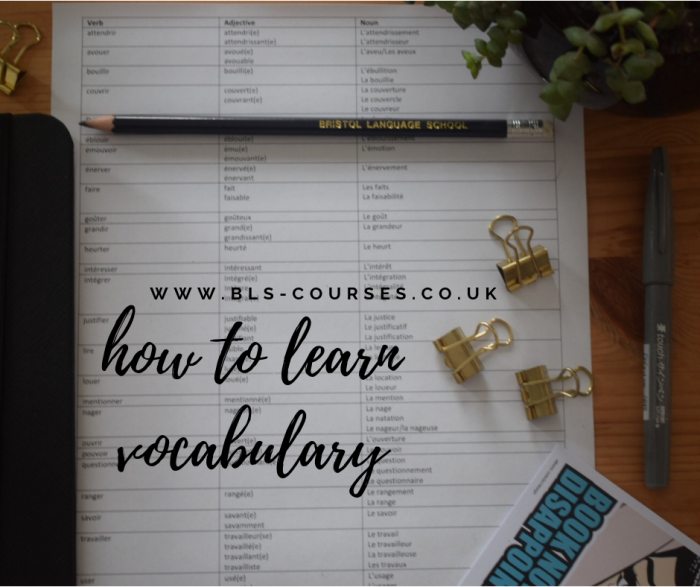————————————————————————————————-
-
Types
of word combinations. Classifications of word-groups. -
Free
word groups. -
Phraseology
as a subsystem of language. -
A
phraseological unit. -
Distinction
between free word-groups and phraseological
units. -
Classification
of phraseological units. -
Sources
of phraseological units.
————————————————————————————————-
1. Types of word combinations. Classifications of word-groups
The
vocabulary of any language consists not only of words but also of
different word groups and expressions.
Words put together to form lexical units make phrases or word-groups.
A word-combination (word-group) is a combination of two or more
words organizes according to the norms of the language. There are
three types of word-groups: 1) free; 2) semi-free (устойчивые);
3) phraseological units.
They are
different structurally and semantically.
2. Free word groups
Free
word combinations
are structurally and semantically unstable, e.g. a
good man;
a
good and reliable man;
a better man,
a
good woman.
They are characterized by the following features:
-
They are
made up by the speaker; they are productive. -
Each word
in a free word combination realizes its own meaning. For example, in
the word-combination a
red rose,
to
write a letter,
extremely
dangerous,
each word has its own meaning, and the meaning of the whole phrase
is the sum of the meanings of its components. -
Substitution
is possible in them.
to walk
fast
to
walk
slowly to move fast
forward
to run
backward
to go
in
the park to drive
in
the forest to fly
Semi-free
or
Fixed
combinations
of
words are
structurally and semantically stable and the meaning is understood
from the meanings of the components. That means there is no
transference of meaning of these combinations, e.g. a
man of business;
a
man of letters
(писатель).
They stand midway between free word-combinations and phrasiological
units. They are characterized in the following way:
-
They are
fixed because they are not made up in speech but are used as
ready-made units. -
The
meaning of the whole can be inferred from the meanings of its
components. -
They are
transitional, semi-productive.
Examples:
soft
landing,
to
commit suicide,
good
luck,
black
coffee,
Merry
Christmas,
Good
afternoon.
3. Phraseology as a subsystem of language
Phraseology
is
a branch of lexicology which studies different types of fixed
expressions, which like words name various objects and phenomena.
They are not created by the speaker but exist in the language as
ready-made units. These word-groups are characterized by stability of
structure and transferred (перенос)
meaning (take
the bull by the horn
–действовать
решительно,
напрямик
= брать
быка
за
рога);
(to
burn one’s boats –
совершать
решительный
поступок,
бесповоротно
разрывая
с
прошлым
= сжечь
корабли);
(to
eat a bushel of salt with –
очень
долгое
время
общаясь,
хорошо
узнать
кого-либо
= съесть
пуд
соли).
Соседние файлы в предмете [НЕСОРТИРОВАННОЕ]
- #
- #
- #
- #
30.04.2022451 Кб2Учебник 213.docx
- #
- #
- #
- #
- #
- #
- #
- Размер: 58 Кб
- Количество слайдов: 27
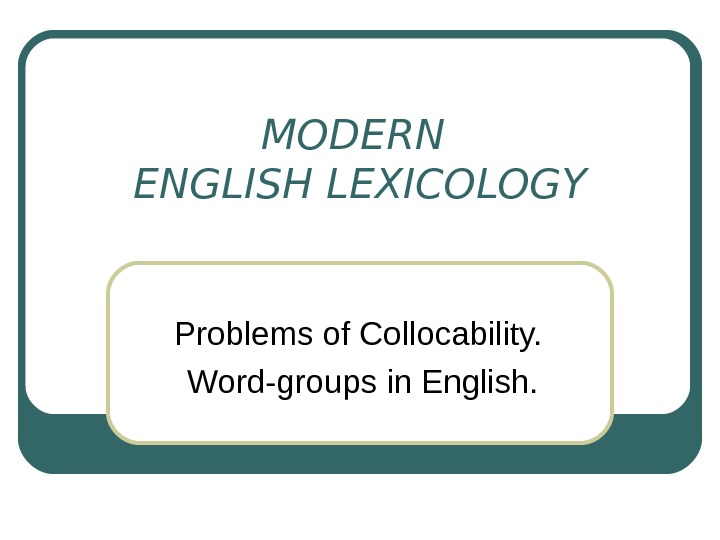
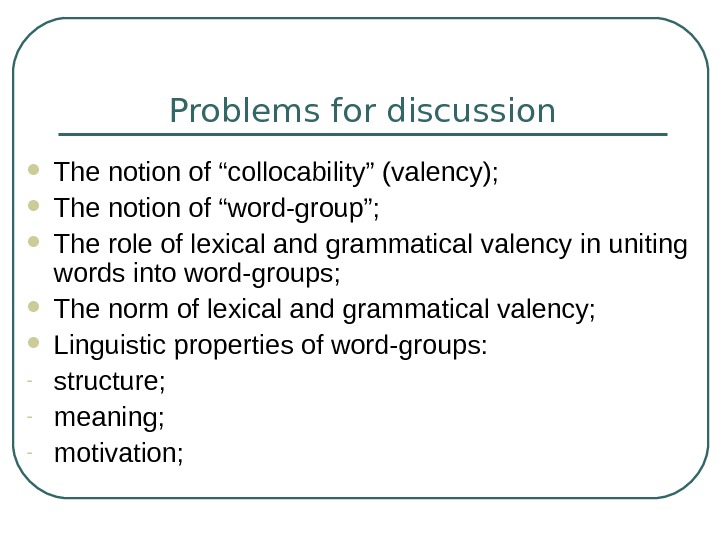
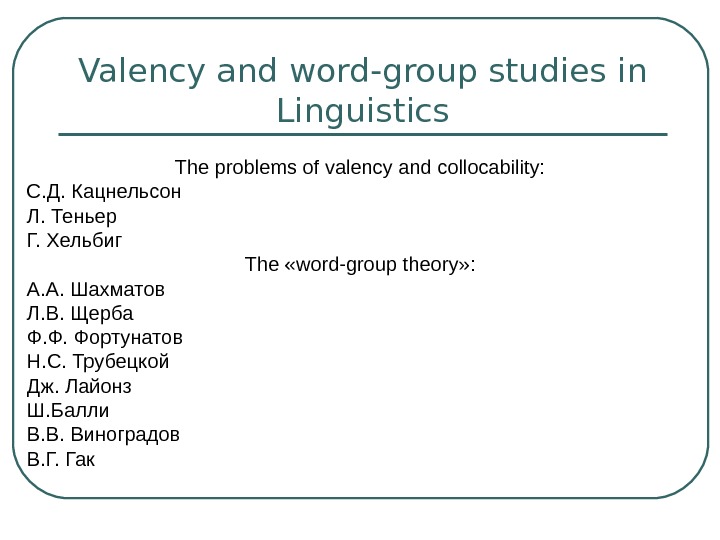
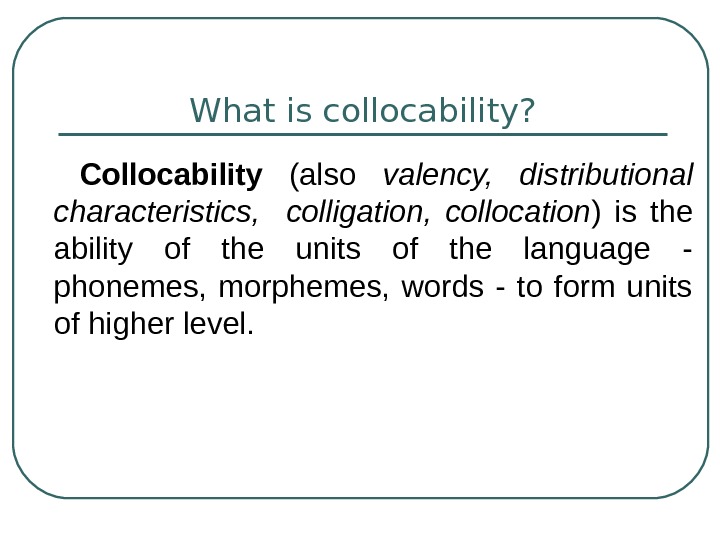
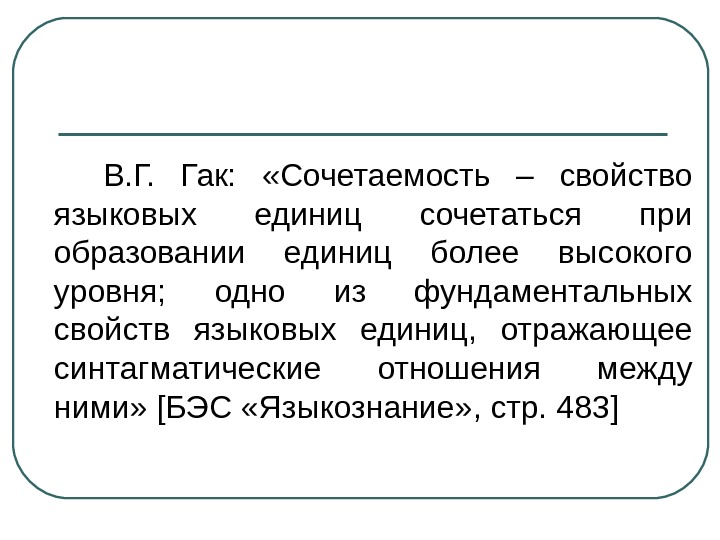

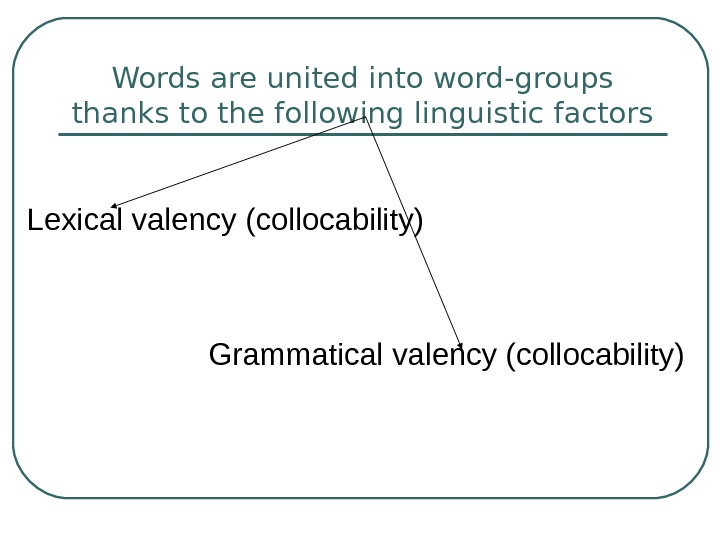
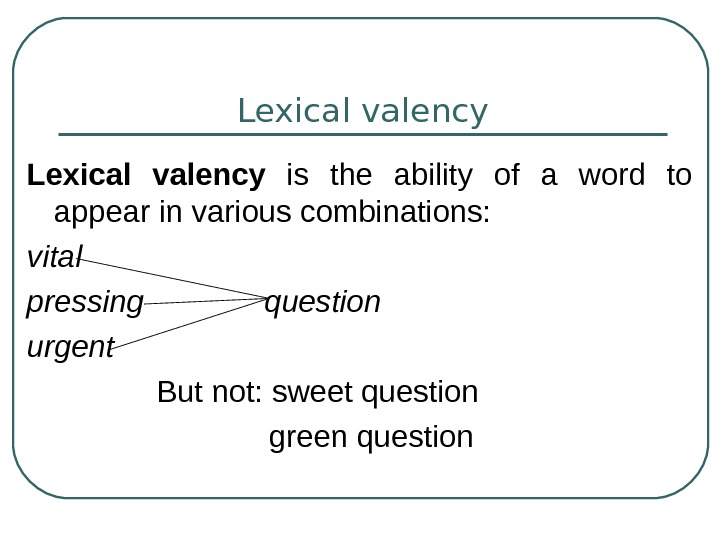
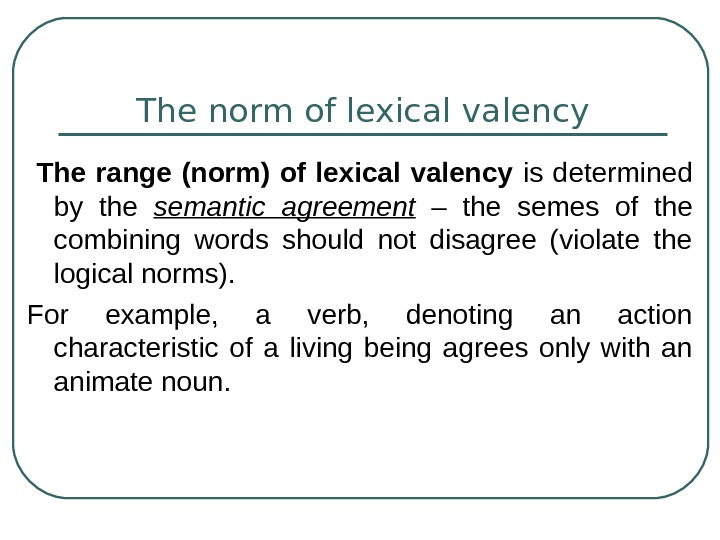
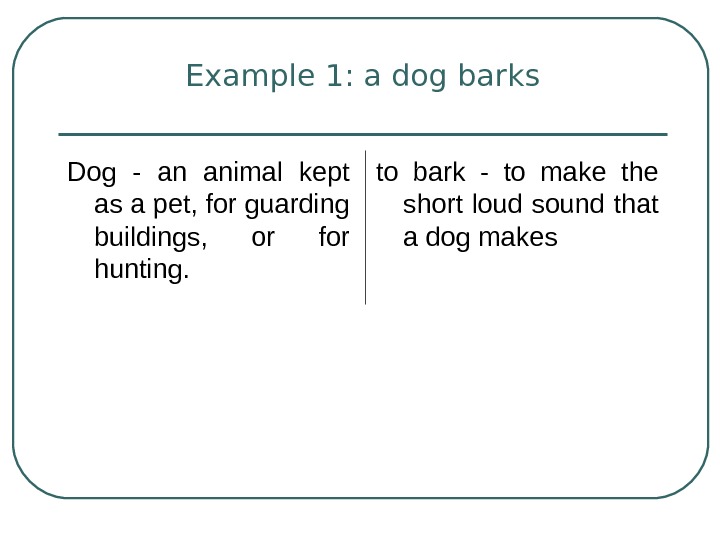
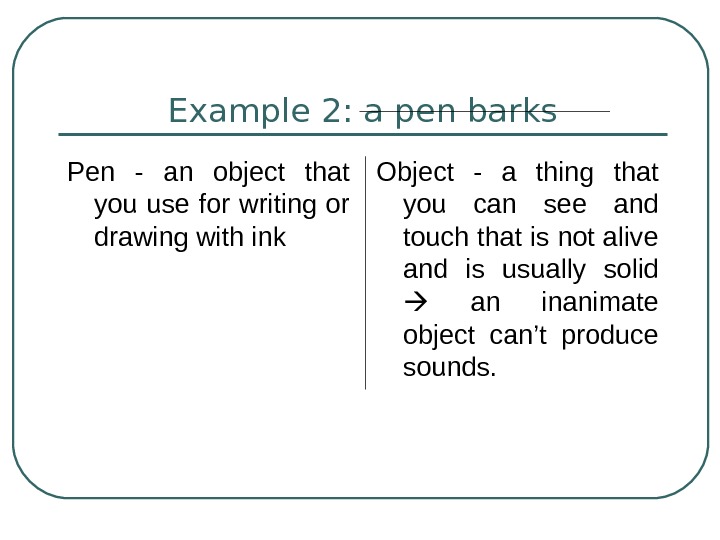


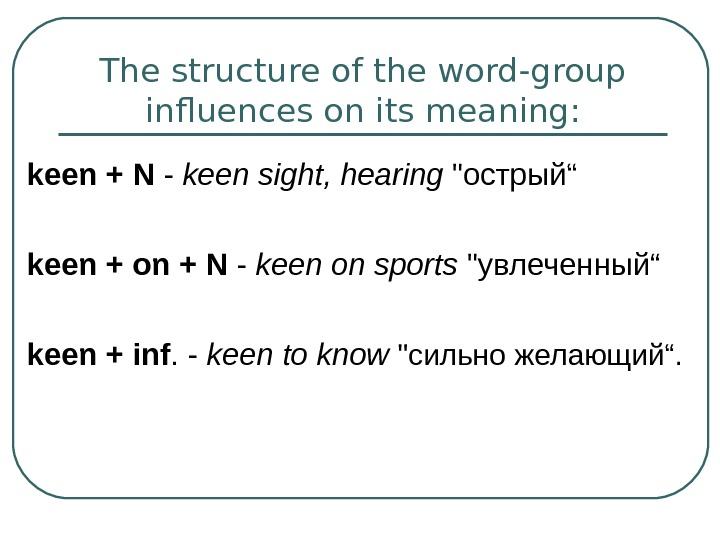

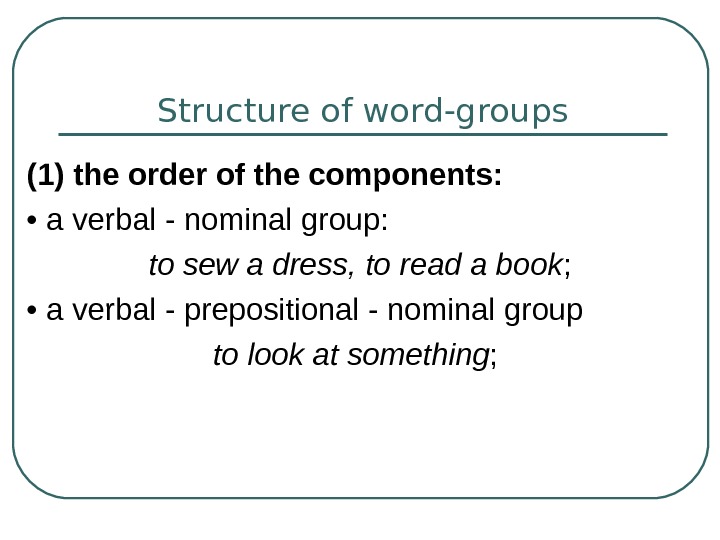
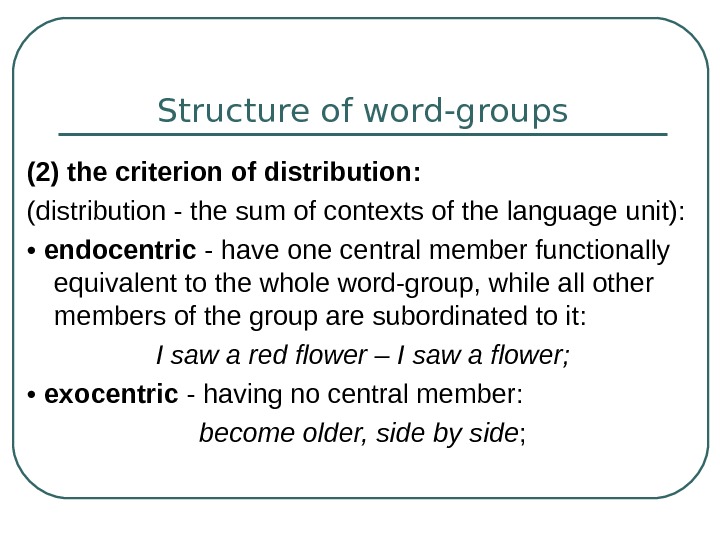
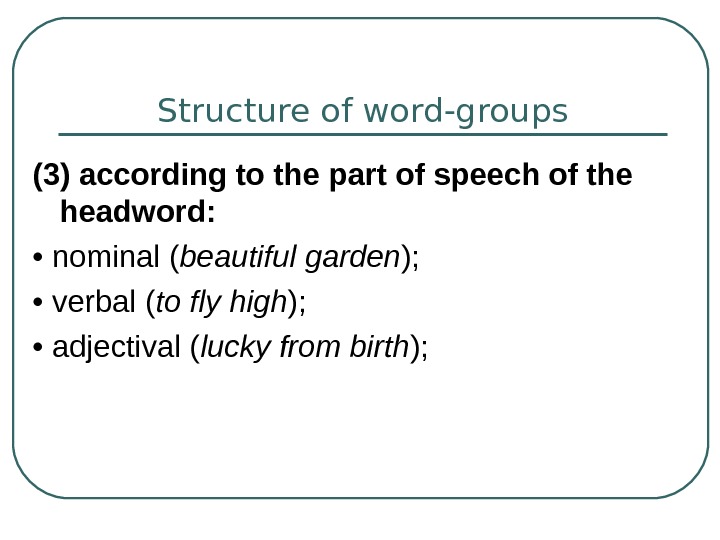
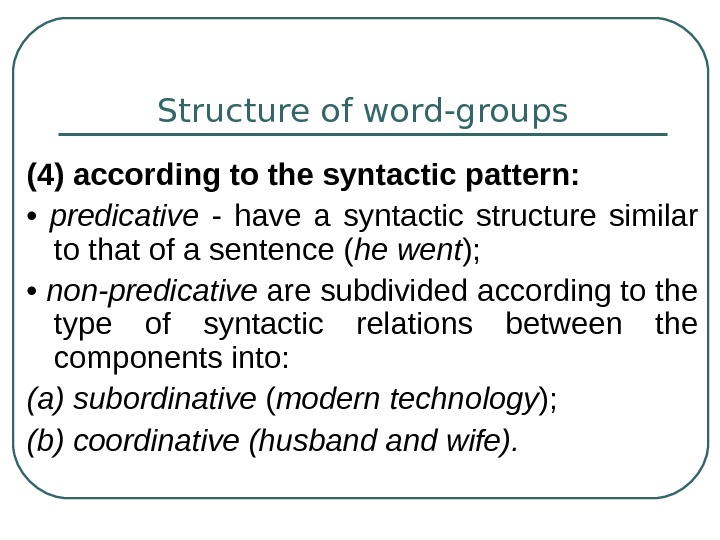

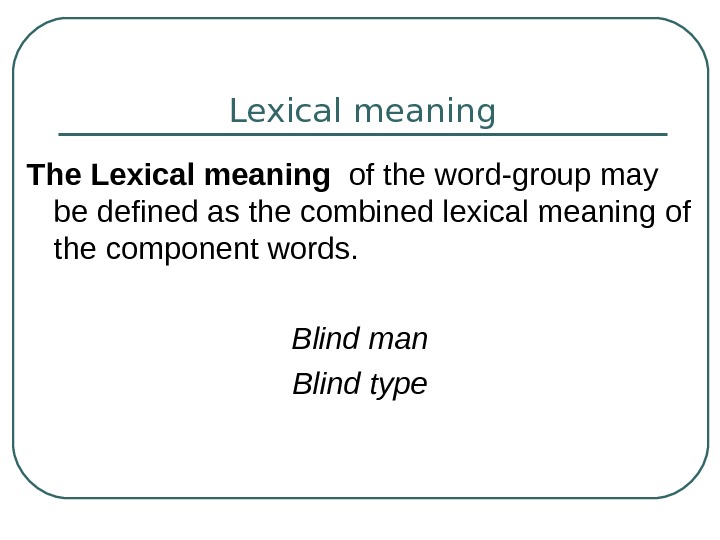
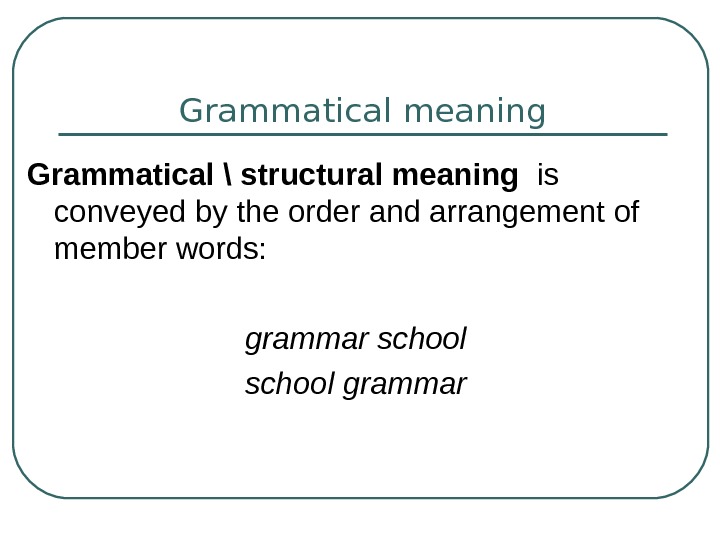
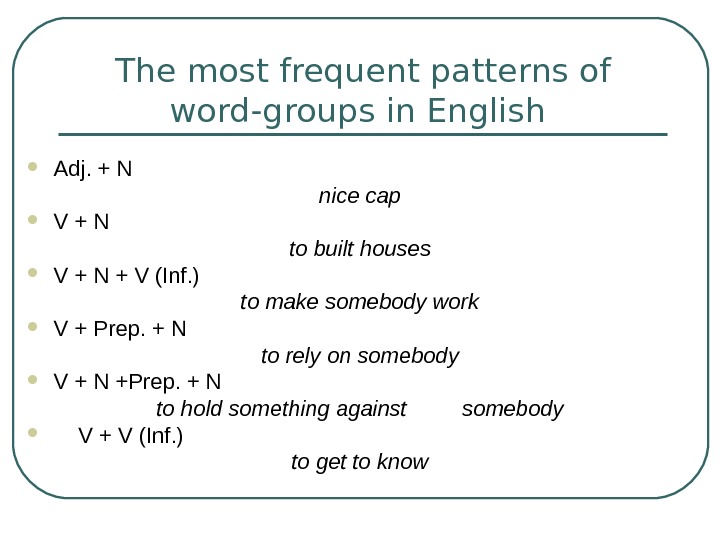
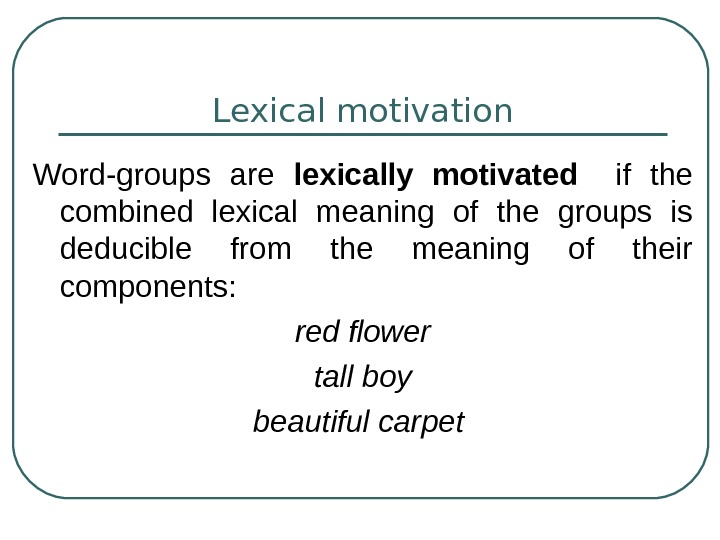
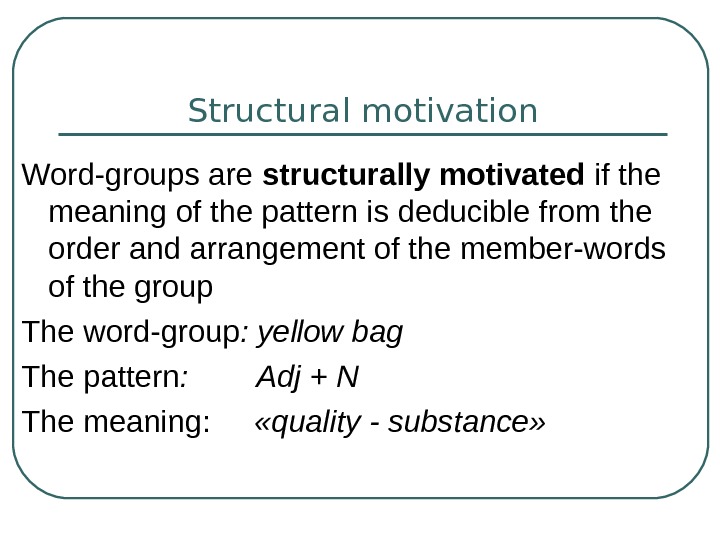
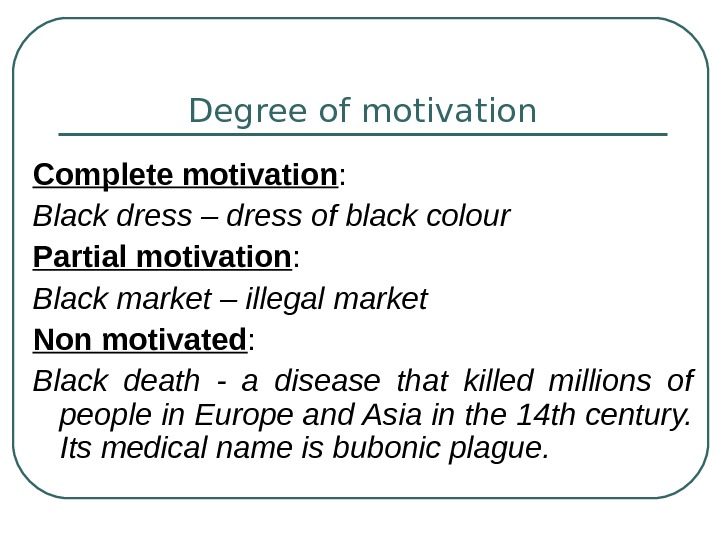
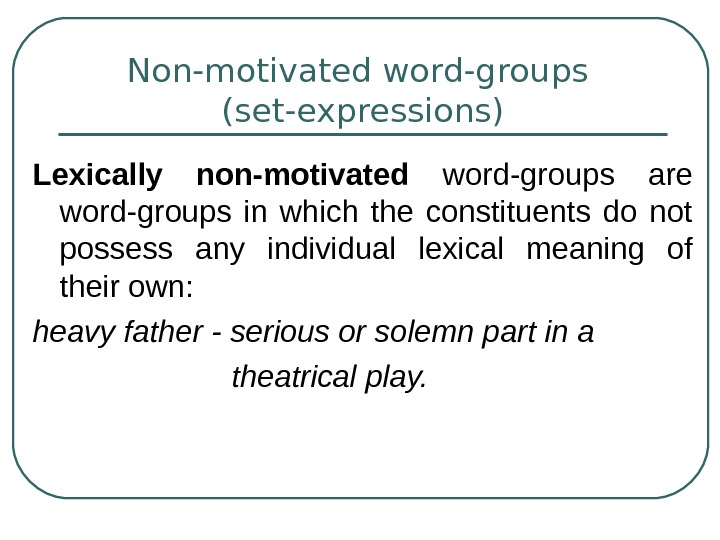
Free word groups and phraseological units
A word-group is the largest two-facet lexical unit comprising more than one word but expressing one global concept.
The lexical meaning of the word groups is the combined lexical meaning of the component words. The meaning of the word groups is motivated by the meanings of the component members and is supported by the structural pattern. But it’s not a mere sum total of all these meanings! Polysemantic words are used in word groups only in 1 of their meanings. These meanings of the component words in such word groups are mutually interdependent and inseparable (blind man – «a human being unable to see», blind type – «the copy isn’t readable).
Word groups possess not only the lexical meaning, but also the meaning conveyed mainly by the pattern of arrangement of their constituents. The structural pattern of word groups is the carrier of a certain semantic component not necessarily dependent on the actual lexical meaning of its members (school grammar – «grammar which is taught in school», grammar school – «a type of school»). We have to distinguish between the structural meaning of a given type of word groups as such and the lexical meaning of its constituents.
It is often argued that the meaning of word groups is also dependent on some extra-linguistic factors – on the situation in which word groups are habitually used by native speakers.
Words put together to form lexical units make phrases or word-groups. One must recall that lexicology deals with words, word-forming morphemes and word-groups.
The degree of structural and semantic cohesion of word-groups may vary. Some word-groups, e.g. at least, point of view, by means, to take place, etc. seem to be functionally and semantically inseparable. They are usually described as set phrases, word-equivalents or phraseological units and are studied by the branch of lexicology which is known as phraseology. In other word-groups such as to take lessons, kind to people, a week ago, the component-members seem to possess greater semantic and structural independence. Word-groups of this type are defined as free word-groups or phrases and are studied in syntax.
Before discussing phraseology it is necessary to outline the features common to various word-groups irrespective of the degree of structural and semantic cohesion of the component-words.
There are two factors which are important in uniting words into word-groups:
– the lexical valency of words;
– the grammatical valency of words.
Lexical valency
Words are used in certain lexical contexts, i.e. in combinations with other words. E.g. the noun question is often combined with such adjectives as vital, pressing, urgent, delicate, etc.
The aptness of a word to appear in various combinations is described as its lexical valency. The range of the lexical valency of words is delimited by the inner structure of the English words. Thus, to raise and to lift are synonyms, but only the former is collocated with the noun question. The verbs to take, to catch, to seize, to grasp are synonyms, but they are found in different collocations:
to take – exams, measures, precautions, etc.;
to grasp – the truth, the meaning.
Words habitually collocated in speech tend to form a cliche.
The lexical valency of correlated words in different languages is not identical, because as it was said before, it depends on the inner structure of the vocabulary of the language. Both the English flower and the Russian цветок may be combined with a number of similar words, e.g. garden flowers, hot house flowers (cf. the Russian – садовые цветы, оранжерейные цветы), but in English flower cannot be combined with the word room, while in Russian we say комнатные цветы (in English we say pot-flowers).
Words are also used in grammatical contexts. The minimal grammatical context in which the words are used to form word-groups is usually described as the pattern of the word-group. E.g., the adjective heavy can be followed by a noun (A+N) – heavy food, heavy storm, heavy box, heavy eater. But we cannot say «heavy cheese» or «heavy to lift, to carry», etc.
The aptness of a word to appear in specific grammatical (or rather syntactical) structures is termed grammatical valency.
The grammatical valency of words may be different. The grammatical valency is delimited by the part of speech the word belongs to. E.g., no English adjective can be followed by the finite form of a verb.
Then, the grammatical valency is also delimited by the inner structure of the language. E.g., to suggest, to propose are synonyms. Both can be followed by a noun, but only to propose can be followed by the infinitive of a verb – to propose to do something.
Clever and intelligent have the same grammatical valency, but only clever can be used in word-groups having the pattern A+prep+N – clever at maths.
Structurally word-groups can be considered in different ways. Word-groups may be described as for the order and arrangement of the component-members. E.g., the word-group to read a book can be classified as a verbal-nominal group, to look at smb. – as a verbal-prepositional-nominal group, etc.
By the criterion of distribution all word-groups may be divided into two big classes: according to their head-words and according to their syntactical patterns.
Word-groups may be classified according to their head-words into:
nominal groups – red flower;
adjective groups – kind to people;
verbal groups – to speak well.
The head is not necessarily the component that occurs first.
Word-groups are classified according to their syntactical pattern into predicative and non-predicative groups. Such word-groups as he went, Bob walks that have a syntactic structure similar to that of a sentence are termed as predicative, all others are non-predicative ones.
Non-predicative word-groups are divided into subordinative and coordinative depending on the type of syntactic relations between the components. E.g., a red flower, a man of freedom are subordinative non-predicative word-groups, red and freedom being dependent words, while day and night, do and die are coordinative non-predicative word-groups.
The lexical meaning of a word-group may be defined as the combined lexical meaning of the component members. But it should be pointed out, however, that the term «combined lexical meaning» does not imply that the meaning of the word-group is always a simple additive result of all the lexical meanings of the component words. As a rule, the meanings of the component words are mutually dependent and the meaning of the word-group naturally predominates over the lexical meaning of the components. The interdependence is well seen in word-groups made up of polysemantic words. E.g., in the phrases the blind man, the blind type the word blind has different meanings – unable to see and vague.
So we see that polysemantic words are used in word-groups only in one of their meanings.
The term motivation is used to denote the relationship existing between the phonemic or morphemic composition and structural pattern of the word on the one hand and its meaning on the other.
There are three main types of motivation:
1) phonetical
2) morphological
3) semantic
1. Phonetical motivation is used when there is a certain similarity between the sounds that make up the word. For example: buzz, cuckoo, gigle. The sounds of a word are imitative of sounds in nature, or smth that produces a characteristic sound. This type of motivation is determined by the phonological system of each language.
2. Morphological motivation – the relationship between morphemic structure and meaning. The main criterion in morphological motivation is the relationship between morphemes. One-morphemed words are non-motivated. Ex – means «former» when we talk about humans ex-wife, ex-president. Re – means «again»: rebuild, rewrite. In borowed words motivation is faded: «expect, export, recover (get better)». Morphological motivation is especially obvious in newly coined words, or in the words created in this century. In older words motivation is established etymologically.
The structure-pattern of the word is very important too: «finger-ring» and «ring-finger». Though combined lexical meaning is the same. The difference of meaning can be explained by the arrangement of the components.
Morphological motivation has some irregularities: «smoker» – si not «the one who smokes», it is «a railway car in which passenger may smoke».
The degree of motivation can be different:
«endless» is completely motivated
«cranberry» is partially motivated: morpheme «cran-» has no lexical meaning.
3. Semantic motivation is based on the co-existence of direct and figurative meanings of the same word within the same synchronous system. «Mouth» denotes a part of the human face and at the same time it can be applied to any opening: «the mouth of a river». «Ermine» is not only the anme of a small animal, but also a fur. In their direct meaning «mouth» and «ermine» are not motivated.
In compound words it is morphological motivation when the meaning of the whole word is based on direct meanings of its components and semantic motivation is when combination of components is used figuratively. For example «headache» is «pain in the head» (morphological) and «smth. annoying» (sematic).
When the connection between the meaning of the word and its form is conventional (there is no perceptible reason for the word having this phonemic and morphemic composition) the word is non-motivated (for the present state of language development). Words that seem non-motivated now may have lost their motivation: «earn» is derived from «earnian – to harvest», but now this word is non-motivated.
As to compounds, their motivation is morphological if the meaning of the whole is based on the direct meaning of the components, and semantic if the combination is used figuratively: watchdog – a dog kept for watching property (morphologically motivated); – a watchful human guardian (semantically motivated).
Every vocabulary is in a state of constant development. Words that seem non-motivated at present may have lost their motivation. When some people recognize the motivation, whereas others do not, motivation is said to be faded.
Semantically all word-groups may be classified into motivated and non-motivated. Non-motivated word-groups are usually described as phraseological units or idioms.
Word-groups may be described as lexically motivated if the combined lexical meaning of the groups is based on the meaning of their components. Thus take lessons is motivated; take place – ‘occur’ is lexically non-motivated.
Word-groups are said to be structurally motivated if the meaning of the pattern is deduced from the order and arrangement of the member-words of the group. Red flower is motivated as the meaning of the pattern quality – substance can be deduced from the order and arrangement of the words red and flower, whereas the seemingly identical pattern red tape (‘official bureaucratic methods’) cannot be interpreted as quality – substance.
Seemingly identical word-groups are sometimes found to be motivated or non-motivated depending on their semantic interpretation. Thus apple sauce, e.g., is lexically and structurally motivated when it means ‘a sauce made of apples’ but when used to denote ‘nonsense’ it is clearly non-motivated
Word-groups like words may be also analyzed from the point of view of their motivation. Word-groups may be called as lexically motivated if the combined lexical meaning of the group is deducible from the meaning of the components. All free phrases are completely motivated.
It follows from the above discussion that word-groups may be also classified into motivated and non-motivated units. Non-motivated word-groups are habitually described as phraseological units or idioms.
Investigations of English phraseology began not long ago. English and American linguists as a rule are busy collecting different words, word-groups and sentences which are interesting from the point of view of their origin, style, usage or some other features. All these units are habitually described as «idioms», but no attempt has been made to describe these idioms as a separate class of linguistic units or a specific class of word-groups.
Difference in terminology («set-phrases», «idioms» and «word-equivalents») reflects certain differences in the main criteria used to distinguish types of phraseological units and free word-groups. The term «set phrase» implies that the basic criterion of differentiation is stability of the lexical components and grammatical structure of word-groups.
There is a certain divergence of opinion as to the essential features of phraseological units as distinguished from other word-groups and the nature of phrases that can be properly termed «phraseological units». The habitual terms «set-phrases», «idioms», «word-equivalents» are sometimes treated differently by different linguists. However these terms reflect to certain extend the main debatable points of phraseology which centre in the divergent views concerning the nature and essential features of phraseological units as distinguished from the so-called free word-groups.
The term «set expression» implies that the basic criterion of differentiation is stability of the lexical components and grammatical structure of word-groups.
The term «word-equivalent» stresses not only semantic but also functional inseparability of certain word-groups, their aptness to function in speech as single words.
The term «idioms» generally implies that the essential feature of the linguistic units under consideration is idiomaticity or lack of motivation. Uriel Weinreich expresses his view that an idiom is a complex phrase, the meaning of which cannot be derived from the meanings of its elements. He developed a more truthful supposition, claiming that an idiom is a subset of a phraseological unit. Ray Jackendoff and Charles Fillmore offered a fairly broad definition of the idiom, which, in Fillmore’s words, reads as follows: «…an idiomatic expression or construction is something a language user could fail to know while knowing everything else in the language». Chafe also lists four features of idioms that make them anomalies in the traditional language unit paradigm: non-compositionality, transformational defectiveness, ungrammaticality and frequency asymmetry.
Great work in this field has been done by the outstanding Russian linguist A. Shakhmatov in his work «Syntax». This work was continued by Acad. V.V. Vinogradov. Great investigations of English phraseology were done by Prof. A. Cunin, I. Arnold and others.
Phraseological units are habitually defined as non-motivated word-groups that cannot be freely made up in speech but are reproduced as ready-made units; the other essential feature of phraseological units is stability of the lexical components and grammatical structure.
Unlike components of free word-groups which may vary according to the needs of communication, member-words of phraseological units are always reproduced as single unchangeable collocations. E.g., in a red flower (a free phrase) the adjective red may be substituted by another adjective denoting colour, and the word-group will retain the meaning: «the flower of a certain colour».
In the phraseological unit red tape (bürokratik metodlar) no such substitution is possible, as a change of the adjective would cause a complete change in the meaning of the group: it would then mean «tape of a certain colour». It follows that the phraseological unit red tape is semantically non-motivated, i.e. its meaning cannot be deduced from the meaning of its components, and that it exists as a ready-made linguistic unit which does not allow any change of its lexical components and its grammatical structure.
Grammatical structure of phraseological units is to a certain degree also stable:
red tape – a phraseological unit;
red tapes – a free word-group;
to go to bed – a phraseological unit;
to go to the bed – a free word-group.
Still the basic criterion is comparative lack of motivation, or idiomaticity of the phraseological units. Semantic motivation is based on the coexistence of direct and figurative meaning.
Taking into consideration mainly the degree of idiomaticity phraseological units may be classified into three big groups. This classification was first suggested by Acad. V.V. Vinogradov. These groups are:
– phraseological fusions,
– phraseological unities,
– phraseological collocations, or habitual collocations.
Phraseological fusions are completely non-motivated word-groups. Themeaning of the components has no connection at least synchronically with the meaning of the whole group. Idiomaticity is combined with complete stability of the lexical components and the grammatical structure of the fusion.
Phraseological unities are partially non-motivated word-groups as their meaning can usually be understood through (deduced from) the metaphoric meaning of the whole phraseological unit.
Phraseological unities are usually marked by a comparatively high degree of stability of the lexical components and grammatical structure. Phraseological unities can have homonymous free phrases, used in direct meanings.
§ to skate on thin ice – to skate on thin ice (to risk);
§ to wash one’s hands off dirt – to wash one’s hands off (to withdraw from participance);
§ to play the first role in the theatre – to play the first role (to dominate).
There must be not less than two notional wordsin metaphorical meanings.
Phraseological collocations are partially motivated but they are made up of words having special lexical valency which is marked by a certain degree of stability in such word-groups. In phraseological collocations variability of components is strictly limited. They differ from phraseological unities by the fact that one of the components in them is used in its direct meaning, the other – in indirect meaning, and the meaning of the whole group dominates over the meaning of its components. As figurativeness is expressed only in one component of the phrase it is hardly felt.
§ to pay a visit, tribute, attention, respect;
§ to break a promise, a rule, news, silence;
§ to meet demands, requirement, necessity;
§ to set free; to set at liberty;
§ to make money, journey;
§ to fall ill.
The structure V + N (дополнение) is the largest group of phraseological collocations.
Phraseological units may be defined as specific word-groups functioning as word-equivalents; they are equivalent to definite classes of words. The part-of-speech meaning of phraseological units is felt as belonging to the word-group as a whole irrespective of the part-of-speech meaning of component words. Comparing a free word-group, e.g. a long day and a phraseological unit, e.g. in the long run, we observe that in the free word-group the noun day and the adjective long preserve the part-of-speech meaning proper to these words taken in isolation. The whole group is viewed as composed of two independent units (A + N). In the phraseological unit in the long run the part-of-speech meaning belongs to the group as a single whole. In the long run is grammatically equivalent to single adverbs, e.g. finally, firstly, etc.
So, phraseological units are included into the system of parts of speech.
Phraseological units are created from free word-groups. But in the course of time some words – constituents of phraseological units may drop out of the language; the situation in which the phraseological unit was formed can be forgotten, motivation can be lost and these phrases become phraseological fusions.
The vocabulary of a language is enriched not only by words, but also by phraseological units. Phraseological units are word-groups that cannot be made in the process of speech, they exist in the language as ready-made units. They are compiled in special dictionaries. The same as words phraseological units express a single notion and are used in a sentence as one part of it. American and British lexicographers call such units «idioms». We can mention such dictionaries as: L. Smith «Words and Idioms», V. Collins «A Book of English Idioms» etc. In these dictionaries we can find words, peculiar in their semantics (idiomatic), side by side with word-groups and sentences. In these dictionaries they are arranged, as a rule, into different semantic groups.
Phraseological units can be classified according to the ways they are formed, according to the degree of the motivation of their meaning, according to their structure and according to their part-of-speech meaning.
A.V. Koonin classified phraseological units according to the way they are formed. He pointed out primary and secondary ways of forming phraseological units.
Among two-top units A.I. Smirnitsky points out the following structural types:
a) attributive-nominal such as: a month of Sundays, grey matter, a millstone round one’s neck and many others. Units of this type are noun equivalents and can be partly or perfectly idiomatic. In partly idiomatic units (phrasisms) sometimes the first component is idiomatic, e.g. high road, in other cases the second component is idiomatic, e.g. first night. In many cases both components are idiomatic, e.g. red tape, blind alley, bed of nail, shot in the arm and many others.
b) verb-nominal phraseological units, e.g. to read between the lines, to speak BBC, to sweep under the carpet etc. The grammar centre of such units is the verb, the semantic centre in many cases is the nominal component, e.g. to fall in love. In some units the verb is both the grammar and the semantic centre, e.g. not to know the ropes. These units can be perfectly idiomatic as well, e.g. to burn one’s boats, to vote with one’s feet, to take to the cleaners’ etc.
Very close to such units are word-groups of the type to have a glance, to have a smoke. These units are not idiomatic and are treated in grammar as a special syntactical combination, a kind of aspect.
c) phraseological repetitions, such as: now or never, part and parcel, country and western etc. Such units can be built on antonyms, e.g. ups and downs, back and forth; often they are formed by means of alliteration, e.g cakes and ale, as busy as a bee. Components in repetitions are joined by means of conjunctions. These units are equivalents of adverbs or adjectives and have no grammar centre. They can also be partly or perfectly idiomatic, e.g. cool as a cucumber (partly), bread and butter (perfectly).
Phraseological units the same as compound words can have more than two tops (stems in compound words), e.g. to take a back seat, a peg to hang a thing on, lock, stock and barrel, to be a shadow of one’s own self, at one’s own sweet will.
Phraseological units can be classified as parts of speech. This classification was suggested by I.V. Arnold. Here we have the following groups:
a) noun phraseologisms denoting an object, a person, a living being, e.g. bullet train, latchkey child, redbrick university, Green Berets,
b) verb phraseologisms denoting an action, a state, a feeling, e.g. to break the log-jam, to get on somebody’s coattails, to be on the beam, to nose out, to make headlines,
c) adjective phraseologisms denoting a quality, e.g. loose as a goose, dull as lead
d) adverb phraseological units, such as: with a bump, in the soup, like a dream, like a dog with two tails,
e) preposition phraseological units, e.g. in the course of, on the stroke of,
f) interjection phraseological units, e.g. «Catch me!», «Well, I never!» etc.
In I.V. Arnold’s classification there are also sentence equivalents, proverbs, sayings and quotations, e.g. «The sky is the limit», «What makes him tick», «I am easy». Proverbs are usually metaphorical, e.g. «Too many cooks spoil the broth», while sayings are as a rule non-metaphorical, e.g. «Where there is a will there is a way».
Теги:
Free word groups. Phraseological units
Контрольная работа
Английский
Просмотров: 27366
Найти в Wikkipedia статьи с фразой: Free word groups. Phraseological units
Lecture № 6. Free Word-groups. Stylistically Marked and Stylistically Neutral Words
Every utterance is a patterned, rhymed and segmented sequence of signals. On the lexical level these signals building up the utterance are not exclusively words. Alongside this separate words speakers use larger blocks consisting of more than one word. Words combined to express ideas and thoughts make up word-groups. The degree of structural and semantic cohesion of words within word-groups may vary. Some word-groups are functionally and semantically inseparable: rough diamond, cooked goose. Such word-groups are traditionally described as set-phrases or phraseological units. Characteristic features of phraseological units are non-motivation for idiomaticity and stability of context. They cannot be freely made up in speech but are reproduced as ready-made units. The component members in other word-groups possess greater semantic and structural independence: to cause misunderstanding, to shine brightly, linguistic phenomenon, red rose. Word-groups of this type are denned as free word-groups for free phrases. They are freely made up in speech by the speakers according to the needs of communication. Set expressions are contrasted to free phrases and semi-fixed combinations. All these different stages of restrictions imposed upon co-occurrence of words, upon the lexical filling of structural patterns which are specific for every language. The restriction may be independent of the ties existing in extra-linguistic reality between the object spoken of and be conditioned by purely linguistic factors, or have extralinguistic causes in the history of the people. In free word-combination the linguistic factors are chiefly connected with grammatical properties of words.
Free word-group is a group of syntactically connected notional words within a sentence, which by itself is not a sentence. This definition is recognized more or less universally in this country and abroad. Though Other linguistics define the term word-group differently — as any group of words connected semantically and grammatically which does not make up a sentence by itself. From this point of view words-components of a word-group may belong to any part of speech, therefore such groups as in the morning, the window, and Bill are also considered to be word-groups (though they comprise only one notional word and one form-word).
STRUCTURE OF FREE WORD-GROUPS
Structurally word-groups may be approached in various ways. All word-groups may be analysed by the criterion of distribution into two big classes. Distribution is understood as the whole complex of contexts in which the given lexical unit can be used. If the word-group has the same linguistic distribution as one of its members, it is described as endocentric i.e. having one central member functionally equivalent to the whole word-group. The word-groups red flower, bravery of all kinds, are distributionally identical with their central components flower and braver, cf: I saw a red flower — 1 saw a flower; I appreciate bravery of all kinds — I appreciate bravery. If the distribution of the word-group is different from either of its members, it is regarded as exocentric i.e. as having no such central member, for instance side by side or grow smaller and others where the component words are not syntactically substitutable for the whole word-group. In endocentric word-groups the central component that has the same distribution as the whole group is clearly the dominant member or the head to which all other members of the group are subordinated, in the word-group red flower the head is the noun flower and in the word-group kind of people the head is the adjective kind.
Word-groups are also classified according to their syntactic pattern into predicative and non-predicative groups. Such word-groups, e.g. John works, he went that have a syntactic structure similar to that of a sentence, are classified as predicative, and all others as non-predicative. Non-predicative word-groups may be subdivided according to the type of syntactic relation between the components into subordinate and coordinative. Such word-groups as red flower, a man of wisdom and the like are termed subordinate in which flower and man are head-words and red, of wisdom are subordinated to them respectively and function as their attributes. Such phrases as woman and child, day and night, do or die are classified as coordinative. Both members in these word-groups are functionally and semantically equal. Subordinate word-groups may be classified according to their head-words into nominal groups (red flower), adjectival groups (kind to people), verbal groups (to speak well), pronominal (all of them). The head is not necessarily the component that comes first in the word-group. In such nominal word-groups as very great bravery, bravery in the struggle the noun bravery is the head whether followed or preceded by other words.
MEANING OF FREE WORD-GROUPS. INTERRELATION OF STRUCTURAL AND LEXICAL MEANINGS IN WORD-GROUPS. MOTIVATION IN WORD-GROUPS
The meaning of word-groups may be defined as the combined lexical meaning of the components. The lexical meaning of the word-group may be defined as the combined lexical meaning of the component words. Thus the lexical meaning of the word-group red flower may be described denotationally as the combined meaning of the words red and flower. It should be pointed out, however, that the term combined lexical meaning is not to imply that the meaning of the word-group is a mere additive result of all the lexical meaning of the component members. As a rule, the meaning of the component words are mutually dependant and the meaning of the word-group naturally predominates over the lexical meanings of its constituents.
Word-groups possess not only the lexical meaning, but also the meaning conveyed by the pattern of arrangement of their constituent’s. Such word groups as school grammar and grammar school are semantically different because of the difference in the pattern of arrangement of the component words. It is assumed that the structural pattern of word-group is the carrier of a certain semantic component which does not necessarily depend on the actual lexical meaning of its members. In the example discussed above school grammar the structural meaning of the word-group may be abstracted from the group and described as equality-substance meaning. This is the meaning expressed by the pattern of the word-group but not by either the word school or the word grammar. It follows that we have to distinguish between the structural meaning of a given type of word-group as such and the lexical meaning of its constituents.
The lexical and structural meaning in word-groups are interdependent and inseparable. The inseparability of these two semantic components in word-groups can be illustrated by the semantic analysis of individual word-groups in which the norms of conventional collocability of words seem to be deliberately overstepped. For instance, in the word-group all the sun long we observe a departure from the norm of lexical valency represented by such word-groups as all the day long, all the night long, all the week long, etc. The structural pattern of these word-groups in ordinary usage and the word-group all the sun long is identical. The generalized meaning of the pattern may be described as “a unit of time”. Replacing day, night, week by another noun the sun we do not find any change in the structural meaning of the pattern. The group all the sun long functions semantically as a unit of time. The noun sun, however, included in the group continues to carry its own lexical meaning (not “a unit of time”) which violates the norms of collocability in this word-group. It follows that the meaning of the word-group is derived from the combined lexical meanings of its constituents and is inseparable from the meaning of the pattern of their arrangement. Word-groups may be also analyzed from the point of view of their motivation. Word groups may be described as lexically motivated if the combined lexical meaning of the group is deducible from the meaning of its components. The degrees of motivation may be different and range from complete motivation to lack of it. Free word-groups, however, are characterized by complete motivation, as their components carry their individual lexical meanings. Phraseological units are described as non-motivated and are characterized by different degree of idiomaticity.
LEXICAL AND GRAMMATICAL VALENCY
Two basic linguistic factors which unite words into word-groups and which largely account for their combinability are lexical valency or collocability and grammatical valency. Words are known to be used in lexical context, i.e. in combination with other words. The aptness of a word to appear in various combinations, with other words is qualified as its lexical collocability or valency. The range of a potential lexical collocability of words is restricted by the inner structure of the language wordstock, This can be easily observed in the examples, as follows: though the words bend, curl are registered by the dictionaries as synonyms their collocability is different, for they tend to combine with different words, cf: to bend a wire/pipe/stick/head/knees; to curl hair/moustache/lips. There can be cases of synonymic groups where one synonym would have the widest possible range of collocability (like shake which enters combinations with an immense number of words including earth, air, mountains, beliefs, spears, walls, souls, tablecloths, carpets etc.) while another will have the limitation inherent in its semantic structure (like wag — to shake a thing by one end, and confined to rigid group of nouns – tail, finger, head, tongue, beard, chin). There is certain norm of lexical valency for each word and any intentional departure from this norm is qualified as a stylistic device, cf: tons of words, a life ago. Words traditionally collocated in speech tend to make up so called cliches or traditional word combinations. In traditional combinations words retain their full semantic independence although they are limited in their combinative power: to wage a war, to render a service, to make friends. Words in traditional combinations are combined according to the patterns of grammatical structure of the given language. Traditional combinations fall into the following structural types:
1 V+N combinations: deal a blow, bear a grudge, take a fancy etc.
-
V+prep+N: fall into disgrace, take into account, come into being etc.
-
V+Adj: work hard, rain heavily etc.
-
V+Adj: set free, make sure, put right etc.
-
Adj+N: maiden voyage, dead silence, feline eyes, aquiline nose etc.
-
N+V: time passes/flies, tastes vary etc.
7. N+prep+N: breach of promise, flow of words, flash of hope, flood of tears etc. Grammatical combinability also tells upon the freedom of bringing words together. The aptness of a word to appear in specific grammatical (syntactic) structures is termed grammatical valency. The grammatical valency of words may be different. The range of it is delimited by the part of speech the word belongs to. This statement, though, does not entitle to say that grammatical valency of words belonging to the same part of speech is identical. Thus, the two synonyms clever and intelligent are said to posses different grammatical valency as the word clever can fit the syntactic pattern of Adj+prep at+N clever at physics, clever at social sciences, whereas the word intelligent can never be found in exactly the same syntactic pattern. Unlike, frequent departures from the norms of lexical valency, departures from the grammatical valency norms are not admissible unless a speaker purposefully wants to make the word group unintelligible to native speakers.
FUNCTIONAL STYLES
The social context in which the communication is taking place determines the modes of speech. When placed in different situations, people instinctively choose different kinds of words and structures to express their thoughts. The suitability or unsuitability of a word for each particular situation depends on its stylistic characteristics or, in other words, on the functional style it represents. The term functional style is generally accepted in modern linguistics. Professor I. V. Arnold defines it as a system of expressive means peculiar to a specific sphere of communication. By the sphere of communication we mean the circumstances attending the process of speech in each particular case: professional communication, a lecture, an informal talk, a formal letter, an intimate letter, a speech in court, etc. All these circumstances or situations can be roughly classified into two types: formal (a lecture, a speech in court, an official letter, professional communication) and informal (an informal talk, an intimate letter). Accordingly, functional styles are classified into two groups, with further subdivisions depending on different situations.
INFORMAL STYLE
Informal vocabulary is used in one’s immediate circle: family, relatives or friends. One uses informal words when at home or when feeling at home. Informal style is relaxed, free-and-easy, familiar and unpretentious. But it should be pointed out that the informal talk of well-educated people considerably differs than that of the illiterate or the semi-educated; the choice of words with adults is different from the vocabulary of teenagers; people living in the provinces use certain regional words and expressions. Consequently, the choice of words is determined in each particular case not only by an informal (or formal) situation, but also by the speaker’s educational and cultural background, age group, and his occupational and regional characteristics. Informal words and word-groups are traditionally divided into three types: colloquial, slang and dialect words and word-groups.
COLLOQUIALISMS (COLLOQUIAL WORDS)
Among other informal words, colloquialisms are the least exclusive: they are used by everybody, and their sphere of communication is comparatively wide, at least of literary colloquial words. These are informal words that are used in everyday conversational speech both by cultivated and uneducated people of all age groups. The sphere of communication of literary colloquial words also includes the printed page, which shows that the term colloquial is somewhat inaccurate. Vast use of informal words is one of the prominent features of 20th and 21st century English and American literature. It is quite natural that informal words appear in dialogues in which they realistically reflect the speech of modern people:
“You’re at some sort of technical college?” she said to Leo, not looking at him….
“Yes. I hate it though: I’m not good enough at maths. There’s a chap there just down from Cambridge who puts us through it. I can’t keep up. Were you good at maths?”
“Not bad. But I imagine school maths are different.”
“Well, yes, they are. I can’t cope with this stuff at all, it’s the whole way of thinking that’s beyond me… I think I’m going to chuck it and take a job.” (From The Time of the Angels by I. Murdoch)
However, in modern fiction informal words are not restricted to conversation, but frequently appear in descriptive passages as well. In this way the narrative is enjoyed with conversational features:
“Fred Hardy was a bad lot. Pretty women, chemin de fer, and an unlucky knack for backing the wrong horse had landed him in the bankruptcy court by the time he was twenty—five…
…If he thought of his past it was with complacency; he had had a good time, he had enjoyed his ups and downs; and now, with good health and a clear conscience, he was prepared to settle down as a country gentleman, damn it, bring up the kids as kids should be brought up; and when the old buffer who sat for his Constituency pegged out, by George, go into Parliament himself.” (From Rain and Other Short Stories by W. S. Maugham)
Here are some more examples of literary colloquial words. Pal and chum are colloquial equivalents of friend; girl, when used colloquially, denotes a woman of any age; bite and snack stand for meal; hi, hello are informal greetings, and so long a form of parting; start, go on, finish and through are also literary colloquialisms; to have a crush on somebody is a colloquial equivalent of to be in love. A bit (of) and a lot (of) also belong to this group. A considerable number of shortenings are found among words of this type: pram, exam, fridge, flu, zip, movie. Phrasal verbs are also numerous among colloquialisms: put up, put over, make up, make out, turn in, etc. Literary colloquial words are to be distinguished from familiar colloquial and low colloquial. The borderline between the literary and familiar colloquial is not always clearly marked. Yet the circle of speakers using familiar colloquial is more limited: these words are used mostly by the young and the semi-educated. This vocabulary group closely verges on slang and has something of its coarse flavour: doc (for doctor), hi (for how do you do), ta-ta (for good-bye), goings-on (for behaviour, usually with a negative connotation), to to pick up smb. (for make a quick and easy acquaintance), go on with you (for let me alone), shut up (for keep silent), beat it (for go away). Low colloquial is defined by G. P. Krapp as uses characteristic of the speech of persons who may be broadly described as uncultivated. This group is stocked with words of illiterate English.
SLANG
The Oxford English Dictionary defines slang as language of a highly colloquial style, considered as below the level of standard educated speech, and consisting either of new words or of current words employed in some special sense. Here is another definition of slang by the famous English writer G. K. Chesterton: The one stream of poetry which in constantly flowing is slang. Every day some nameless poet weaves some fairy tracery of popular language… Slang is metaphor, and all metaphor is poetry….The world of slang is a kind of topsy-turvydom of poetry, full of blue moons and white elephants, of men losing their heads, and men whose tongues run away with them — a whole chaos of fairy tales. All or most slang words are current words whose meanings have been metaphorically shifted. Each slang metaphor is rooted in a joke, but not in a kind or amusing joke. This is the criterion for distinguishing slang from colloquialisms: most slang words are metaphors and jocular, often with a coarse, mocking, cynical colouring. This is one of the common objections against slang: a person using a lot of slang seems to be sneering and jeering at everything under the sun. This objection is psychological. There are also linguistic ones. H. McKnight notes that originating as slang expressions often do, in an insensibility to the meaning of legitimate words, the use of slang checks an acquisition of a command over recognized modes of expression… and must result in atrophy of the faculty of using language. W. Fowler states that as style is the great antiseptic, so slang is the great corrupting matter, it is perishable, and infects what is round it. McKnight also notes that no one capable of good speaking or good writing is likely to be harmed by the occasional employment of slang, provided that he is conscious of the fact…
People use slang for a number of reasons: to be picturesque, arresting, striking and, above all, different from others; to avoid the tedium of outmoded hackneyed common words, to demonstrate one’s spiritual independence and daring, to sound moden and up-to-date. It doesn’t mean that all these aims are achieved by using slang. Nor are they put in so many words by those using slang on the conscious level. But these are the main reasons for using slang as explained by modern psychologists and linguists. The circle of users of slang is more narrow than that of colloquialisms. It is mainly used by the young and uneducated. Yet, slang’s colourful and humorous quality makes it catching, so that a considerable part of slang may become accepted by nearly all the groups of speakers.
DIALECT WORDS
H. W. Fowler defines a dialect as a variety of a language which prevails in a district, with local peculiarities of vocabulary, pronunciation and phrase. England is a small country, yet it has many dialects which have their own distinctive features (e. g. the Lancashire, Dorsetshire, Norfolk dialects). So dialects are regional forms of English. Standard English is defined by the Random House Dictionary as the English language as it is written and spoken by literate people in both formal and informal usage and that is universally current while incorporating regional differences. Dialectal peculiarities, especially those of vocabulary, are constantly being incorporated into everyday colloquial speech or slang. From these levels they can be transferred into the common stock, i.e. words which are not stylistically marked and a few of them even into formal speech and into the literary language.
FORMAL STYLE
Formal style is restricted to formal situations. In general, formal words fall into two (words associated with professional communication and a less exclusive group of so-called learned words.
LEARNED WORDS
These words are mainly associated with the printed page. It is in this vocabulary stratum that poetry and fiction find their main resources. The term learned is not precise and does not adequately describe the exact characteristics of these words. A some what out-of-date term for the same category of words is bookish. The term learned includes several heterogeneous subdivisions of words. We find here numerous words that are used in scientific prose and can be identified by their dry, matter-of-fact flavour, e.g. compile, experimental, heterogeneous, homogeneous, conclusive etc. To this group also belongs so-called officialese (cf. with the Rus. канцеляризмы). These are the words of the official, bureaucratic language: assist (for help), proceed (for go), approximately (for about), sufficient (for enough), attired (for dressed), inquire (for ask).
Probably the most interesting subdivision of learned words is represented by the words found in descriptive passages of fiction. These words, which may be called literary, also have a particular flavour of their own, usually described as refined. They are mostly polysyllabic words drawn from the Romance languages and, though fully adapted to the English phonetic system, some of them continue to sound singularly foreign. They also seem to retain an aloofness associated with the lofty contexts in which they have been used for centuries. Their very sound seems to create complex and solemn associations, e.g. sentiment, fascination, meditation, felicity, elusive, cordial, illusionary. There is one further subdivision of learned words: modes of poetic diction. These stand close to the previous group many words from which, in fact, belong to both these categories. Yet, poetic words have a further characteristic – a lofty, high-flown, sometimes archaic, colouring: “…constancy lives in realms above; And life is thorny; and youth is vain; And to be wroth with one we love, Doth work like madness in the brain…” (Coleridge)
Though learned words are mainly associated with the printed page, this is not exclusively so. Any educated English-speaking individual is sure to use many learned words not only in his formal letters and professional communication but also in his everyday speech. It is true that sometimes such uses strike a definitely incongruous note as in the following extract: “You should find no difficulty in obtaining a secretarial post in the city.” Carel said “obtaining a post” and not “getting a job”. It was part of a bureaucratic manner which, Muriel noticed, he kept reserved for her.” (From The Time of the Angels by I. Murdoch)
Yet, generally speaking, educated people in both modern fiction and real life is learned words quite naturally and their speech is certainly the richer for it. On the other hand, excessive use of learned elements in conversational speech presents grave hazards. Utterances overloaded with such words have pretensions of refinement and; elegance but achieve the exact opposite verging on the absurd and ridiculous. Writers use this phenomenon for stylistic purposes. When a character in a book or in a play uses too many learned words, the obvious inappropriateness of his speech in an informal situation produces a comic effect: “The story of your romantic origin as relate” to me by mamma, with unpleasing comments, has naturally stirred the deepest fibres of my nature. Your Christian name has an irresistible fascination. The simplicity of your nature makes you exquisitely incomprehensible to me…” (Oscar Wilde’s The Importance of Being Earnest).
Eliza Doolitfle in Pygmalion by B. Shaw engaging in traditional English small tall answers the question “Will it rain, do you think?” in the following way: ”The shallow depression in the west of these islands is likely to move slowly in an easterly direction. There are no indications of any great change in the barometrical situation.” However any suggestion that learned words are suitable only for comic purposes; would be quite wrong. It is in this vocabulary stratum that writers and poets find their most vivid paints and colours, and not only their humorous effects. Here is an extract from Iris Murdoch describing a summer evening: “… A bat had noiselessly appropriated the space between, a flittering weaving almost substanceless fragment of the invading dark…. A collared dove groaned once in the final light. A pink rose reclining upon the big box hedge glimmered with contained electric luminosity. A blackbird, trying to metamorphose itself into a nightingale, began a long passionate complicated song.” (From The Sacred and Profane Love Machine by I. Murdoch)
ARCHAIC AND OBSOLETE WORDS
These words stand close to the learned words, particularly to the modes of poetic dictions. Learned words and archaisms are both associated with the printed page. Yet many learned words may also be used in conversational situations. This cannot happen with archaisms, which are invariably restricted to the printed page. These words are moribund, already partly or fully out of circulation, rejected by the living language! Their last refuge is in historical novels (whose authors use them to create a particular period atmosphere) and, of course, in poetry which is rather conservative in its choice of words. Thou and thy, aye (yes) and nay (no) are certainly archaic and long since rejected by common usage, yet poets use them even today. We also find the same four words and many other archaisms among dialectisms, which is quite natural, as dialects are also conservative and retain archaic words and structures. Further examples of archaisms are: morn (for morning), eve (for evening), damsel (for girl), errant (for wandering, e. g. errant knights), etc. Sometimes, an archaic word may undergo a sudden revival. So, the formerly archaic Hit (for relatives; one’s family) is now current in American usage. The terms archaic and obsolete are used more or less indiscriminately by some authors. Others make a distinction between them using the term obsolete for words which have completely gone out of use. The Random House Dictionary defines an obsolete word like one no longer in use, esp. out of use for at least a century, whereas an archaism is referred to as current in an earlier time but rare in present usage. It should be pointed out that the borderline between obsolete and archaic is vague and uncertain, and in many cases it is difficult to decide to which of the groups this or that word belongs. There is a further term for words which are no longer in use: historisms. By this we mean words denoting objects and phenomena which are, things of the past and no longer exist.
PROFESSIONAL TERMINOLOGY
Hundreds of thousands of words belong to special scientific, professional or trade terminological systems and are not used or even understood by people outside the particular speciality. Every field of modern activity has its specialized vocabulary. There is a special medical vocabulary, and similarly special terminologies for psychology, botany, music, linguistics, teaching methods and many others.
Term is a word or a word-group which is specifically employed by a particular branch of science, technology, trade or the arts to convey a concept peculiar to this particular activity. There are several controversial problems in the field of terminology. The first is the puzzling question of whether a term loses its terminological status when it comes into common usage. There are linguists in whose opinion terms are only those words which have retained their exclusiveness and are not known or recognized outside their specific sphere. There is yet another point of view, according to which any terminological system is supposed to include all the words and word-groups conveying concept peculiar to a particular branch of knowledge, regardless of their exclusiveness. Modern research of various terminological systems has shown that there is no impenetrable wall between terminology and the general language system. To the contrary, terminologies seem to obey the same rules and laws as other vocabulary strata. Therefore, exchange between terminological systems and the common vocabulary is quite normal, and it would be wrong to regard a term; as something special and standing apart. Two other controversial problems deal with polysemy and synonymy. According to some linguists, an ideal term should be monosemantic (i.e. it should have only one meaning). Polysemantic terms may lead to misunderstanding, and that is a serious shortcoming in professional communication. This requirement seems quite reasonable, yet facts of the language do not meet it. There are, in actual fact, numerous polysemantic terms. The same is true about synonymy in terminological systems. There are scholars who insist that terms should not have synonyms because, consequently, scientists and other specialists would name the same objects and phenomena in their field by different terms and would not be able to come to any agreement. This may be true. But, in fact, terms do possess synonyms. In painting, the same term colour has several synonyms in both its meanings: hue, shade, tint, tinge in the first meaning (колір) and paint, tint, dye in the second (фарба).
BASIC VOCABULARY
These words are stylistically neutral, and, in this respect, opposed to formal and informal words described above. Their stylistic neutrality makes it possible to use them in all kinds of situations, both formal and informal, in verbal and written communication. Certain of the stylistically marked vocabulary strata are, in a way, exclusive: professional terminology is used mostly by representatives of the professions; dialects are regional; slang is favoured mostly by the young and the uneducated. Not so basic vocabulary. These words are used every day, everywhere and by everybody, regardless of profession, occupation, educational level, age group or geographical location. These are words without which no human communication would be possible as they denote objects and phenomena of everyday importance, e.g. house, bread, summer, winter, child, mother, green, difficult, to go, to stand, etc. The basic vocabulary is the central group of the vocabulary, its historical foundation and living core. That is why words of this stratum show a considerably greater stability in comparison with words of the other strata, especially informal. Basic vocabulary words can be recognised not only by their stylistic neutrality but, also, by entire lack of other connotations (i.e. attendant meanings). Their meanings are broad; general and directly convey the concept, without supplying any additional information. T
he basic vocabulary and the stylistically marked strata of the vocabulary do not exist independently but are closely interrelated. Most stylistically marked words have their neutral counterparts in the basic vocabulary. Terms are an exception in this respect. On the other hand, colloquialisms may have their counterparts among learned words, most slang has counterparts both among colloquialisms and learned words. Archaisms, naturally, have their modern equivalents at least in some of the other groups.
Table 1 gives some examples of such synonyms belonging to different stylistic strata, Table 2 sums up the description of the stylistic strata of English vocabulary.
|
Stylistically-neutral words |
Stylistically-marked words |
|
|
Informal |
Formal |
|
|
Basic vocabulary |
I. Colloquial words |
I. Learned words |
|
A. literary, |
A. literary, |
|
|
B. familiar, |
B. words of scientific prose, |
|
|
C. low. |
C. officialese, |
|
|
II. Slang words. |
D. modes of poetic diction. |
|
|
III. Dialect words. |
II. Archaic and obsolete words. |
|
|
III. Professional |
||
|
terminology. |
49
Ministry of Education of the Russian Federation
Free Word-groups and Phraseological units
Done by: Ivanova Ksenija
Group: 701(2)
Ishim, 2013
Content
-
Introduction________________________________________Page№3
-
Phraseological Units and word-groups___________________Page№4
-
Classification of Phraseological units____________________Page№6
-
The etymological classification of phraseological units____________Page№8
-
How to Distinguish Phraseological Units
from Free Word-Groups___________________________________Page№9
-
Сonclusion_________________________________________Page№11
-
Bibliography_______________________________________Page№12
Introduction
Phraseology is a scholarly approach to language which developed in the twentieth century [1]. It took its start when Charles Bally’s notion of locutions phraseologiques entered Russian lexicologyand lexicography in the 1930s and 1940s and was subsequently developed in the former Soviet Union and other Eastern European countries. From the late 1960s on it established itself in (East) German linguistics but was also sporadically approached in English linguistics. The earliest English adaptations of phraseology are by Weinreich (1969) within the approach of transformational grammar), Arnold (1973), and Lipka (1992) [2].
In Great Britain as well as other Western European countries, phraseology has steadily been developed over the last twenty years. The activities of the European Society of Phraseology and the European Association for Lexicography with their regular conventions and publications attest to the prolific European interest in phraseology. Bibliographies of recent studies on English and general phraseology are included in Welte (1990) and specially collected in Cowie & Howarth (1996) whose bibliography is reproduced and continued on the internet and provides a rich source of the most recent publications in the field [3].
Phraseological Units and Word-group
Phraseology is a branch of lexicology studying phraseological units (set expressions, praseologisms, or idioms (in foreign linguistics).
Phraseological units differ from free word-groups semantically and structurally:
1) they convey a single concept and their meaning is idiomatic, i.e. it is not a mere total of the meanings of their components
2) they are characterized by structural invariability (no word can be substituted for any component of a phraseological unit without destroying its sense (to have a bee in one’s bonnet (not cap or hat).
3) they are not created in speech but used as ready-made units.
A word-group is the largest two-facet lexical unit comprising more than one word but expressing one global concept.
The lexical meaning of the word groups is the combined lexical meaning of the component words. The meaning of the word groups is motivated by the meanings of the component members and is supported by the structural pattern. But it’s not a mere sum total of all these meanings! Polysemantic words are used in word groups only in 1 of their meanings. These meanings of the component words in such word groups are mutually interdependent and inseparable (blind man – «a human being unable to see», blind type – «the copy isn’t readable).
Word groups possess not only the lexical meaning, but also the meaning conveyed mainly by the pattern of arrangement of their constituents. The structural pattern of word groups is the carrier of a certain semantic component not necessarily dependent on the actual lexical meaning of its members (school grammar – «grammar which is taught in school», grammar school – «a type of school»). We have to distinguish between the structural meaning of a given type of word groups as such and the lexical meaning of its constituents.
Words put together to form lexical units make phrases or word-groups. One must recall that lexicology deals with words, word-forming morphemes and word-groups.
The degree of structural and semantic cohesion of word-groups may vary. Some word-groups, e.g. at least, point of view, by means, to take place, etc. seem to be functionally and semantically inseparable. They are usually described as set phrases, word-equivalents or phraseological units and are studied by the branch of lexicology which is known as phraseology. In other word-groups such as to take lessons, kind to people, a week ago, the component-members seem to possess greater semantic and structural independence. Word-groups of this type are defined as free word-groups or phrases and are studied in syntax.
Structurally word-groups can be considered in different ways. Word-groups may be described as for the order and arrangement of the component-members. E.g., the word-group to read a book can be classified as a verbal-nominal group, to look at smb. – as a verbal-prepositional-nominal group, etc.
By the criterion of distribution all word-groups may be divided into two big classes: according to their head-words and according to their syntactical patterns.
Word-groups may be classified according to their head-words into:
nominal groups – red flower;
adjective groups – kind to people;
verbal groups – to speak well.
The head is not necessarily the component that occurs first.
Word-groups are classified according to their syntactical pattern into predicative and non-predicative groups. Such word-groups as he went, Bob walks that have a syntactic structure similar to that of a sentence are termed as predicative, all others are non-predicative ones.
Non-predicative word-groups are divided into subordinative and coordinative depending on the type of syntactic relations between the components. E.g., a red flower, a man of freedom are subordinative non-predicative word-groups, red and freedom being dependent words, while day and night, do and die are coordinative non-predicative word-groups [4].
Classification of Phraseological units
Phraseological units are classified in accordance with several criteria.
In the classification proposed by acad. Vinogradov Phraseological units are classified according to the semantic principle, and namely to the degree of motivation of meaning, i.e. the relationship between the meaning of the whole unit and the meaning of its components. Three groups are distinguished: phraseological fusions (сращения), phraseological unities (единства), phraseological combinations (сочетания).
1. Phraseological fusions are non-motivated. The meaning of the whole is not deduced from the meanings of the components: to kiss the hare’s foot (опаздывать), to kick the bucket (сыграть в ящик), the king’s picture (фальшивая монета)
2. Phraseological unities are motivated through the image expressed in the whole construction, the metaphores on which they are based are transparent: to turn over a new leaf, to dance on a tight rope.
3. Phraseological combinations are motivated; one of their components is used in its direct meaning while the other can be used figuratively: bosom friend, to get in touch with.
Prof. Smirnitsky classifies phraseological units according to the functional principle. Two groups are distinguished: phraseological units and idioms.
Phraseological units are neutral, non-metaphorical when compared to idioms: get up, fall asleep, to take to drinking. Idioms are metaphoric, stylistically coloured: to take the bull by the horns, to beat about the bush, to bark up the wrong tree.
Structurally prof. Smirnitsky distinguishes one-summit (one-member) and many-summit (two-member, three-member, etc.) phraseological units, depending on the number of notional words: against the grain (не по душе), to carry the day (выйти победителем), to have all one’s eggs in one basket.
Prof. Amosova classifies phraseological units according to the type of context. Phraseological units are marked by fixed (permanent) context, which can’t be changed: French leave (but not Spanish or Russian). Two groups are singled out: phrasemes and idioms.
1. Prasemes consist of two components one of which is praseologically bound, the second serves as the determining context: green eye (ревнивый взгляд), green hand (неопытный работник), green years (юные годы), green wound (незажившая рана), etc.
2. Idioms are characterized by idiomaticity: their meaning is created by the whole group and is not a mere combination of the meanings of its components: red tape (бюрократическая волокита), mare’s nest (нонсенс), to pin one’s heart on one’s sleeve (не скрывать своих чувств).
Prof. Koonin’s classification is based on the function of the phraseological unit in communication. Phraseological units are classified into: nominative, nominative-communicative, interjectional, communicative.
1. Nominative phraseological units are units denoting objects, phenomena, actions, states, qualities. They can be:
a) substantive – a snake in the grass (змея подколодная), a bitter pill to swallow;
b) adjectival – long in the tooth (старый);
c) adverbial – out of a blue sky, as quick as a flash;
d) prepositional – with an eye to (с намерением), at the head of.
2. Nominative-communicative units contain a verb: to dance on a volcano, to set the Thames on fire (сделать что-то необычное), to know which side one’s bread is buttered, to make (someone) turn (over) in his grave, to put the hat on smb’s misery (в довершение всех его бед).
3. Interjectional phraseological units express the speaker’s emotions and attitude to things: A pretty kettle of fish! (хорошенькое дельце), Good God! God damn it! Like hell!
4. Communicative phraseological units are represented by provebs (An hour in the morning is worth two in the evening; Never say “never”) and sayings. Sayings, unlike provebs, are not evaluative and didactic: That’s another pair of shoes! It’s a small world.
In dictionaries of idioms the traditional and oldest principle for classifying phraseological units – the thematic principle – is used.
The etymological classification of phraseological units
According to their origin phraseological units are divided into native and borrowed.
Native phraseological units are connected with British realia, traditions, history:
By bell book and candle (jocular) – бесповоротно. This unit originates from the text of the form of excommunication (отлучение от церкви) which ends with the following words: Doe to the book, quench the candle, ring the book!
To carry coal to Newcastle (parallells: Ехать в Тулу со своим самоваром, везти сов в Афины, везти пряности в Иран)
According to Cocker – по всем правилам, точно. E. Cocker is the author of a well-known book on arithmetics.
To native phraseological units also belong familiar quotations came from works of English literature. A lot of them were borrowed from works by Shakespeare: a fool’s paradise (“Romeo and Juliet”), the green-eyed monster (“Othello”), murder will out – шила в мешке не утаишь (“Macbeth”), etc.
A great number of native phraseological units originate from professional terminologies or jargons: one’s last card, the game is up/over lay one’s cards on the table hold all the aces (terms of gambling).
Borrowed phraseological units come from several sources.
A number of units were borrowed from the Bible and were fully assimilated: to cast pearl before swine, the root of all evil, a woolf in sheep’s clothing, to beat swords into plough-shares.
A great amount of units were taken from ancient mythology and literature: the apple of discord, the golden age, the thread of Ariadne, at the greek calends ( до греческих календ, никогда), etc, They are international in their character.
A lot of phraseologisms were borrowed from different languages – let’s return to our muttons (revenons à nos moutons), blood and iron (принцип политики Бисмарка – Blut und Eisen), blue blood, to lose face (кит. tiu lien) and from the other variants of the English language (AmE) – a green light, bark up the wrong tree, to look like a million dollars, time is money (B. Franklin “Advice to a Young Tradesman”).
How to Distinguish Phraseological Units from Free Word-Groups
The task of distinguishing between free word-groups and phraseological units is further complicated by the existence of a great number of marginal cases, the so-called semi-fixed or semi-free word-groups, also called non-phraseological word-groups which share with phraseological units their structural stability but lack their semantic unity and figurativeness (e. g. to go to school, to go by bus, to commit suicide). There are two major criteria for distinguishing between phraseological units and free word-groups: semantic and structural.
The semantic shift affecting phraseological units does not consist in a mere change of meanings of each separate constituent part of the unit. The meanings of the constituents merge to produce an entirely new meaning: e. g. to have a bee in one’s bonnet means «to have an obsession about something; to be eccentric or even a little mad». The humorous metaphoric comparison with a person who is distracted by a bee continually buzzing under his cap has become erased and half-forgotten, and the speakers using the expression hardly think of bees or bonnets but accept it in its transferred sense: «obsessed, eccentric».
In the traditional approach, phraseological units have been defined as word-groups conveying a single concept (whereas in free word-groups each meaningful component stands for a separate concept). The structural criterion brings forth pronounced distinctive features characterising phraseological units and contrasting them to free word-groups. Structural invariability is an essential feature of phraseological units, though, as we shall see, some of them possess it to a lesser degree than others.
Structural invariability of phraseological units finds expression in a number of restrictions:
1) restriction in substitution. As a rule, no word can be substituted for any meaningful component of a phraseological unit without destroying its sense.
2) The second type of restriction is the restriction in introducing any additional components into the structure of a phraseological unit. In a free word-group such changes can be made without affecting the general meaning of the utterance.
3) The third type of structural restrictions in phraseological units is grammatical invariability. Yet again, as in the case of restriction in introducing additional components, there are exceptions to the rule and these are probably even more numerous. One can build a castle in the air, but also castles.
Conclusion
The Phraseological units are closely connected with people’s mentality .The present day English can’t be considered full of value without idiomatic usage, as the use of idioms is the first sign of a certain language’s developing. Idiomatic sentences enrich a language and the knowledge of idioms signal that the speaker knows the language on the level of a native speaker. The belles-lettres investigated by us revealed a great number of idiomatic sentences used by prominent writers in their works to make their language more expressive and colourful. This research proposes practical hints for teachers wishing to diverse their lessons with idioms.
So idioms are integral part of language which make our speech more colourful and authentically native.
Bibliography
1.Knappe, Gabriele. (2004) Idioms and Fixed Expressions in English Language Study before 1800. Peter Lang;
2.Weinreich, Uriel (1969) Problems in the Analysis of Idioms. In J. Puhvel (ed.), Substance and Structure of Language, 23-81. Berkeley/Los Angeles: University of California Press;
3.Arnold, I.V. (1973) The English Word Moscow: Higher School Publishing House;
4.Internet site: http://www.roman.by/r-177452.html
5.Amоsоvа N. N. (1963) Basic course in English phraseology L;
6. Koonin А.V.( 1972) Phraseology of modern English. M.;
7. Vinogradov V.V. (1977) The chief types of Phraseological units in the Russian Language. – M.;
8. Zikova I.V.( 2005) А Practical Course in English Lexicology. М;
|
0 |
Free Word-groups and Phraseological units
In this blog post, we look at a useful way to help us remember vocabulary – putting words into groups. We find out how to harness our brain’s natural tendency to understand the world through association (this object is green and has leaves – it must be a plant!) to help us create groups of related words that will help us learn and remember them. We can create groups based on different things: themes, verbs/nouns and adjectives, synonyms, prefixes – these are just a few that we explore here.
I know what you’re thinking, another post on learning vocabulary! But this technique is different from the visualisation technique or the recognising cognates technique we explored in other blog posts. And remember, everyone is different and so everyone learns a language differently – and once you have worked out which type of language learner you are and which techniques work for you, you will have a recipe for success!
Grouping By Theme/Context
You will have heard it before, context is key to language learning. Children learn that “hello” means “hello” because people say it to them when they see them for the first time and not when they are going away (that’s “bye bye”). They learn that “yummy” is an adjective to describe food but not, say books. We are no different from children in the way we learn. When we associate words with a context, we learn and remember them more quickly. I can assure you that you will remember that “cucchiaio” means “spoon” in Italian much more readily if you are using it to eat soup with than if you ask, “how do you say ‘spoon’?” in a car trip across the Alps and then try to remember it after a fun day’s skiing.
So, how do you group words by theme? Try drawing and labelling a picture. Draw a picture of the kitchen in your house and label all the things in there, draw a picture of the human body and label the parts, draw a picture of a car and label that. If you are learning words that go together or make up a whole, you will remember them more easily. Learn words about the weather together, learn how to say whether you are well/ill/have a headache/have a toothache together. Learn words you will use in the classroom together. Learn words and phrases you will need to use in a restaurant (“I’ll have a…”, “the bill, please!”). You will remember them better than if you are learning random clusters of words.
Making Nouns and Adjectives out of Verbs
I remember when I learnt this technique to learn three words for the price of one – I was literally excited because it opened my eyes to a new, efficient way of learning!
Think of a verb in the language you are learning. Let’s take “éclairer” (to brighten/become clear/clarify) in French. If we look in a dictionary near “éclairer”, we will see “éclaircie” – a clear patch in a cloudy sky (which metaphorically means an improvement in a difficult situation), and “éclaircissement”, clarification. We will also see the adjective “éclairé”, informed/enlightened. With this exercise, we have just learnt four words instead of just one. Try this with verbs you can think of. You can combine this grouping technique with tools such as tables and diagrams if this will help you.
Learning Synonyms
Another way to learn several words instead of just one word at a time is to learn synonyms. It is a good idea to use a thesaurus for this exercise. Think of the word “hungry” in English. How many synonyms can you think of? “Famished”? “Starving”? “Ravenous”? “Peckish”? Try looking up synonyms in the language you are learning and use them in conversation instead of the standard word. This will help you remember them because you are using them and may impress your friends!
Grouping Words by Prefix
It is likely that the language you are learning will use prefixes (beginnings of words) that have a specific meaning. Let’s look at Spanish. If we know that “des-“ means “un-“ or “not”, we can work out that “desconocido” (des-conocido) means “unknown” and “desbloquear” means “to unblock”. “Descubrir”, literally “to uncover”, means “to find out/discover” (it’s similar in English). This amazing word is similar in a lot of languages – “scoprire” in Italian is “to uncover” or “discover”, “ontdekken” in Dutch is the same and “odkrywać” in Polish is similar. These words all have prefixes (s-, ont-, od-) which also mean “un-”, “away” or “from” in the respective languages. If we identify these little parts of words, we can understand the gist if not the meaning of new words and remember them because of their theme (such as “un-“ meanings).
Can you think of other ways to group vocabulary together? Share them with us in the comments!
Suzannah Young

